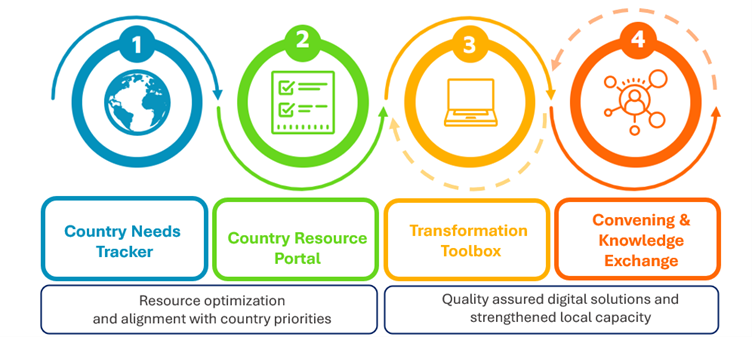Table of Contents
United Nations Security Council (UNSC)
Context: The United States vetoed the UNSC resolution that called for an immediate ceasefire in Gaza.
About UNSC
- Premier Global Body: The UN Security Council stands as the leading international entity tasked with the preservation of global peace and security.
- Established: 1946
- Binding Authority: It holds the capacity to enact binding resolutions upon the 193 UN member states to uphold peace.
- Crisis Management: Regular sessions are convened to address international security threats, including civil conflicts, natural calamities, the spread of weapons, and terrorist activities.
Composition of the UN Security Council
- Permanent Members: The council comprises 15 members, with permanent seats held by China, France, Russian Federation, the United States, and the United Kingdom.
- Elected Members: Annually, 10 non-permanent member states are chosen by the UNGA for a two-year tenure.
- Regional Allocation: Non-permanent seats are regionally allocated, with five for African and Asian states (including a rotating Arab candidate), one for Eastern Europe, two for Latin America and the Caribbean, and two for Western Europe and others.
Presidency Rotation of the UNSC
- Presidential Opportunity: Each non-permanent member is granted the chance to preside over the council during its membership term.
- Monthly Transition: The presidency rotates monthly among members following the English alphabetical order of the member states’ names.
We’re now on WhatsApp. Click to Join
Veto Power in the UN Security Council
- Definition of Veto: The UN recognizes the ‘veto’ as a unique voting right that allows any of the five permanent members to block a resolution by casting a negative vote.
- Exclusive to P5 members: This veto power is exclusive to the Permanent Five (P5) countries of the Security Council, namely China, France, Russia, the United States, and the United Kingdom.
- Non-permanent Members Exclusion: The ten non-permanent members of the UNSC do not possess the veto privilege.
- Article 27 of the UN Charter: The article stipulates that each UNSC member has one vote and that decisions on procedural matters are made with a minimum of nine affirmative votes from the total of fifteen members.
- Requirement for Substantive Decisions: For decisions on non-procedural matters, not only is a minimum of nine affirmative votes required, but these must also include the concurrence of all permanent members.
Global Initiative on Digital Health
Context: The Global Initiative on Digital Health (GIDH) was launched by the World Health Organization (WHO) as part of the priorities agreed upon during India’s G20 presidency in 2023).
About Global Initiative on Digital Health (GIDH)
- Purpose: The GIDH is a platform for sharing knowledge and digital products among countries, aimed at enhancing the digital transformation of health systems globally.
- Aim:
- ALIGN efforts to support the Global Strategy on Digital Health 2020–2025;
- SUPPORT quality assured technical assistance to develop and strengthen standards-based and interoperable systems aligned to global best practices, norms and standards;
- FACILITATE the deliberate use of quality assured digital transformation tools that enable governments to manage their digital health transformation journey.

- Components: The initiative will work through a network of networks with four main components
- A country needs tracker,
- A country resource portal,
- A map of resources available in a country, and
- A transformation toolbox with quality-assured digital tools and knowledge exchange.
- Contribution to India’s Digital Health: The launch of GIDH aligns with India’s ongoing efforts to digitise its health system, including managing the largest vaccination drive through its CoWIN platform, and the Ayushman Bharat Digital Mission, which aims to create a seamless electronic health record system in the country.
Kapilvastu Relics
Context: 4 of 20 relics of Buddha preserved at the National Museums are being taken to Thailand for a month-long exhibition.
About Kapilavastu Relics
- Origin: The relics were recovered in 1898 from a site in Bihar believed to be the ancient city of Kapilavastu.
- Inscription: An inscribed casket found at the stupa site in Piprahwa (near Siddharthanagar in Uttar Pradesh) helped identify Kapilavastu. This casket contained the relics of Buddha.
- Significance: These relics are considered highly significant in Buddhism as they are connected to the historical Buddha.
- Category: They fall under the ‘AA’ (rare) category of antiquities and are not meant to be taken out of India for exhibition.
- This special classification underscores their extraordinary value and the need for their preservation.
- Exhibitions: Despite the general restriction on international exhibition, the relics have been displayed abroad, such as in Mongolia in 2022.
- Cultural Importance: The display of these relics is a major cultural event involving multiple stakeholders, including the Ministry of Culture, the Ministry of External Affairs of India, the International Buddhist Confederation, and the Madhya Pradesh government.
Defining Forests
Context: The Supreme Court has directed governments to follow the “broad and all-encompassing” definition of forest as laid down in its 1996 judgement in the T N Godavarman case until a consolidated record of all kinds of forests across the country is prepared.
Why the Forest (Conservation) Act Was Amended in 2023?
Background and Justification:
- The Forest (Conservation) Act (FCA) was amended in 2023 to address the widened applicability brought about by the Supreme Court’s 1996 judgement in T N Godavarman Thirumalpad v. Union of India.
- The amendments aimed to remove ambiguities and make the FCA applicable only to notified forests and lands identified as ‘forest’ in government records, potentially excluding 28% of India’s forests.
Supreme Court’s Definition of ‘Forest’:
- The Supreme Court defined ‘forest’ based on its dictionary meaning, covering all statutorily recognized forests and any area recorded as forest in government records.
- This broad definition significantly expanded the FCA’s ambit to include all lands with forest-like characteristics, not just reserved forests.
Impact of the SC’s 1996 Judgment:
- The 1996 judgement expanded the FCA’s scope beyond ‘reserved forests’ to any land that qualified as a forest, including unreserved and private lands.
- In 2022, the Supreme Court reiterated that the FCA applies to any forest land as understood in the dictionary sense.
Arguments Against the 1996 T N Godavarman Judgment
- Impediment to Welfare: The government argued that the broad interpretation of the FCA was obstructing development activities, even basic welfare projects for tribal communities.
- Forest Rights Act Overlap: Development needs of tribal communities are addressed under the Forest Rights Act, 2006, suggesting that an FCA amendment may not have been necessary for these purposes.
Current Situation and Next Steps
- Record Consolidation: States and UTs must submit comprehensive records of forests as identified by expert committees following the 1996 judgement.
- Publication of Data: The Ministry is to publish the data on its website.
- Supreme Court’s Directive: The SC has asked for its 1996 definition of ‘forest’ to be followed until the finalisation of the consolidated record.
- Expert Committees’ Role: The new expert committees formed under the 2023 Rules can consider previous findings but are also free to extend protection to any land deemed worth conserving.
Lab Grown Diamond
Context: Indian lab-grown diamond exports value tripled by 2022, volume up 25% year-on-year (Oct 2023). However, prices plummeted 58% in 2023 due to surging supply.
About Lab-Grown Diamonds (LGDs)
- Also known as synthetic diamonds or cultured diamonds.
- Created in a laboratory environment, not naturally formed deep within the Earth.
- Have the same chemical composition, crystal structure, and physical properties as natural diamonds.
- Different from diamond simulants, which look like diamonds but have different compositions and properties.
- Examples of diamond simulants include Moissanite, Cubic Zirconia (CZ), White Sapphire, YAG, etc.
How LDGs are Produced?
- Two primary methods:
- High-Pressure High-Temperature (HPHT)
- Places a small diamond seed in a chamber under high pressure and temperature.
- Carbon atoms from a source crystallize around the seed, growing into a larger diamond.
- Usually, graphite is used as the seed.
- Chemical Vapour Deposition (CVD)
- Places a diamond seed in a chamber filled with carbon-rich gases.
- Gases are ionised, causing carbon atoms to separate and deposit on the seed, layer by layer.
- Layers build up, resulting in a complete diamond.
- High-Pressure High-Temperature (HPHT)
Characteristics and Applications of LGDs
- Similar basic properties to natural diamonds, including optical dispersion (diamond sheen).
- Created in controlled environments, so many properties can be enhanced for various purposes.
- Most often used for industrial purposes, in machines and tools.
- Hardness and extra strength make them ideal for use as cutters.
- Pure synthetic diamonds have high thermal conductivity but negligible electrical conductivity.
- Used in electronics as heat spreaders for high-power laser diodes, laser arrays, and high-power transistors.


 Monasteries in India: List of Major and ...
Monasteries in India: List of Major and ...
 National Doctor’s Day 2025: History, T...
National Doctor’s Day 2025: History, T...
 Bonalu Festival 2025: Date, History, Rit...
Bonalu Festival 2025: Date, History, Rit...





















